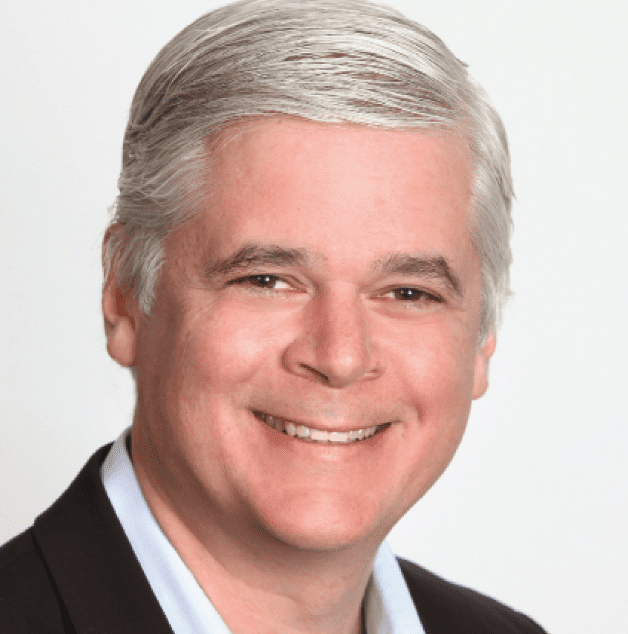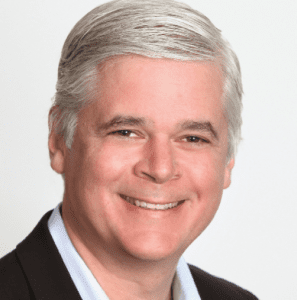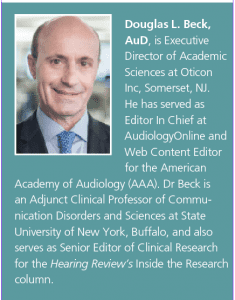Inside the Research | July 2018 Hearing Review
Brent Edwards, PhD, has been a prominent figure in hearing healthcare R&D since the 1990s. With doctorates in electrical engineering and psychology, he spent much of his academic career researching how to apply signal processing techniques to the human auditory system and conducting psychoacoustic research. He then went on to work in industry, directing research departments that combined engineering, hearing science, and audiology for the development of new technologies. Last year, Dr Edwards became the director of the National Acoustic Laboratories (NAL) in Sydney, Australia, one of the world’s premiere hearing research centers. With me visiting Australia, and this month’s focus on audiology and neuroscience, it seemed natural to catch up with Dr Edwards.
Beck: Good morning, Brent. Great to visit with you in person, and congratulations on your new position as director of NAL.
Edwards: Thanks Doug. Welcome to Sydney, Australia!
Beck: Brent, would you please briefly review a little bit of the history and role of NAL?
Edwards: Absolutely. NAL evolved from a few different entities starting in 1943. In 1944, it became the Acoustic Research Laboratory. It went through various name changes and functions. However, in 1991, the hearing healthcare component was separated from the research division, with the former named Australian Hearing Services and the latter keeping the name the National Acoustic Laboratories, with Denis Byrne, PhD, as the first director of research. As you know Doug, Dr Byrne died about 17 years ago, and our mutual friend Dr Harvey Dillon took over as director. Harvey retired—well, semi-retired really!—in 2017, and I was fortunate enough to be appointed as the third director of NAL.
Beck: And, of course, the contributions and accomplishments of the professionals associated with NAL have made a huge difference across the globe with regard to hearing, hearing loss, aural rehabilitation, auditory processing, pediatric and adult hearing aid fittings, cochlear implants, and so much more.
Edwards: I agree, Doug. I am honored to do all I can to keep pushing forward the evidence-based boundaries of research with regard to the areas you’ve just mentioned, and of course, to explore new exciting areas. NAL has been terrific at advancing the science of hearing and bringing pragmatic applicability to the clinicians through tools like the COSI, the NAL fitting prescriptions, and the LiSN-S test for spatial processing disorder.
What surprised me when I took over as director of NAL was the breadth of research that is conducted here—from psychosocial understanding of hearing aid management, to sophisticated outcome measures with virtual 3D audio, to novel diagnostics for pediatric assessments, and more.
Beck: And, as far as “more” goes, let’s talk about cortical evoked potentials.
Edwards: Great. NAL has developed a unique product called HEARLab, which is a cortical auditory evoked potential (CAEP) system. HEARLab is useful when you’ve got patients who are very difficult to fit, whether they are babies or adults who cannot participate in their own care due to cognitive, brain, or behavioral development issues. So, given a patient who is unable to subjectively respond to amplification, and despite having excellent probe-mic measures, it would still be very useful to see that the brain is able to identify and respond to speech sounds. HEARLab provides that via a more-or-less modified EEG, and it is commercially available as a turn-key system. It was first approved by the FDA in 2013.
Beck: And so HEARLab verifies that the brain is responding to sound?
Edwards: Yes. It’s a diagnostic unit and uses a small number of electrodes, through which we can determine whether the auditory cortex is receiving speech sounds. Once we know the acoustics are right with real-ear measures, we take it a step further and ask, “Is the brain perceiving, and can the brain decode the speech components and differentiate between different consonants?” Because, as you know, even if you’re delivering a high-fidelity acoustic signal with appropriate audibility, if the brain cannot differentiate between speech sounds, then the patient will struggle with communication.
While the current HEARLab measures the detectability of speech sounds, we are developing a module that will measure whether speech sounds can be discriminated. For example, consider a 3-month-old baby with a profound sensorineural hearing loss who has just been fitted with hearing aids. If the CAEP indicates the child’s brain is perceiving different consonants while wearing acoustic amplification, then the measurement supports a long-term hearing aid fitting. However, if the CAEP does not indicate sufficient decoding and differentiation of speech sounds, the clinician might make an alternative management recommendation, such as a cochlear implant (CI). However, to be clear, this wouldn’t tell anyone that a CI will be successful, just that the auditory cortex is not receiving sufficient speech information with the fitted hearing aid.
Beck: And, if I recall, NAL has developed specific stimuli for speech sounds?
Edwards: Exactly. These sounds are presented over a short time period, and the responses are robust if the cortex is decoding the stimuli. If the cortex is not, the response is more or less flat and indistinguishable from background noise. We believe this will be a highly successful and extremely useful tool for clinicians.
Beck: And it can easily help make decisions earlier, as we generally like to see children who are candidates for CIs receive the devices perhaps between 6 and 12 months, based on their physical development and other assessments by their surgeon.
Edwards: Exactly. So that’s one scenario for using the HEARLab, but it would also contribute to the assessment of an adult who was unable to participate in his/her own care, too.
Beck: Okay, let’s move on to a rather awkward financial question, if you don’t mind? I believe I read something about NAL’s funding sources changing. Is that correct?
Edwards: Yes, that is correct. As you know, NAL is a government research lab within Australian Hearing and, as such, receives funding from the Australian government. But to pursue the breadth of research that NAL has successfully conducted over the years, NAL has relied on its participation in the HEARing Cooperative Research Centre (CRC) program for such important projects as the Longitudinal Outcomes for Children with Hearing Impairment (LOCHI) study that has so far tracked over 400 children with hearing loss from birth up to, by now, 9 years of age.
The development of HEARLab was done under the HEARing CRC. In fact, the CRC even funded the development of the NAL-NL2 fitting prescription. The CRC disbands next year, and therefore we are adjusting our strategic focus to ensure that NAL can continue with its meaningful research beyond the CRC. This means that the research we do will be more focused on clinical impact, and one way of doing this is to partner with organizations who can bring the results of our research into the clinic.
We will also be looking to incubate technology and work with the entrepreneurial community as another way to bring NAL innovations to the clinic. We want to have a meaningful clinical impact with everything we do, which means that our focus will be on improving the lives of people with hearing loss, improving the ability of audiologists to treat their clients, or improving the ability of companies to develop solutions for both of those groups. And, hopefully, we’ll be having fun along the way.
Beck: That’s very exciting as the potential for NAL to become even more foundational in the industry and the profession seems unlimited.
Edwards: Thanks. My new mantra is “Innovation for Impact.” Everything we do has to be inventive and creative, produce a strong evidence base, and must have an impact on as many people as possible. Part of how we will achieve this is by adopting Silicon Valley’s approach to innovation, using a customer-focused approach to our research inspired by design thinking and lean startup methodology—fail fast and learn faster. To steal from Tesla, we are upgrading from insane mode to ludicrous mode.
Beck: And what about NAL creating OTC-type hearing aids?
Edwards: We’re not going to do that. We may partner with companies that are developing novel devices, such as hearables, in order to help those with hearing loss who reject traditional devices, but we’re never going to produce and sell hearing devices ourselves—that’s not our strength.
Beck: And speaking of OTC—particularly in the USA—what are your thoughts, please?
Edwards: Well, Doug, the recent article you and Gary Rosenblum published pretty much summed it up.1 OTC devices in various forms have been available for over 40 years. Access to these products has been available through mail order or Internet sales, and there have been low-cost alternatives for decades—just Google “cheap hearing aids” and see what you get!
So, as you said, OTC is already here and has been for a long time. It’s just that the FDA has not yet formalized or published their guidelines, and those are due in 2020. There’s also lots of work left to do with regard to how to make a customer successful while trying to obtain and self-fit an OTC product—to maximize their hearing and listening in difficult listening situations.
In brief, OTC is not going to undermine the hearing industry or audiology community. When the FDA finishes its work, you’ll have 50 or more companies who believe that 80% of people with hearing loss who do not currently wear hearing aids will want to purchase some sort of inexpensive self-fitting device.
I really do not believe that 80% number is correct, and I wrote about “the 20% myth” more than a decade ago in The Hearing Review.2 I suspect that manufacturers of OTC devices are going to find that the viable market is a lot smaller than they think. Combine the smaller profit margins on OTC products with the much higher return and repair numbers (compared to other consumer electronics products) and this business model will not make financial sense for many manufacturers.
Liz Convery’s recent research at NAL has demonstrated that the majority of people with hearing loss were unable to successfully self-fit a hearing aid, and her research identified what factors are required to be successful at self-fitting [submitted article; Convery et al, “Factors associated with the setup of a self-fitting hearing aid and the need for personalized support”]. Our future research in this area will focus on understanding: 1) What are the barriers to success; 2) What is required from the technology to be successful; 3) What are appropriate expectations for self-fitting, and 4) What are the ways in which the hearing care professional contributes to the successful fitting of a patient.
MarkeTrak VIII3 was pretty clear that the greater the one-to-one care and adherence to best practices the patient receives from their hearing care professional, the higher the satisfaction rates. And so again, I’m not worried about OTC putting hearing aid companies or dispensing clinics out of business or dramatically changing the professional-patient landscape. I do think that OTC devices will expand the number of people who wear hearing aids by offering a solution to consumers who are currently rejecting traditional devices—it’s just that providing successful OTC hearing aids is not going to be as easy or as largely adopted as people currently believe.
Beck: Okay, Brent, I know we’re out of time. Thanks and congratulations again on your new position. I’ll look forward to decades of new and exciting success from NAL, and our continued friendship.
Edwards: Thanks Doug. I appreciate your friendship, time, and interest in NAL, too.
Correspondence to Dr Beck at: [email protected]
Citation for this article: Beck DL. NAL, CAEPs, OTC hearing aids, and more: An interview with Brent Edwards, PhD. Hearing Review. 2018;25(7):40-41.
References
-
Rosenblum G, Beck DL. Over the counter hearing aids: Opinions and perspectives 2018. The Hearing Professional.2018:35-55. Available at: https://ihsinfo.org/IhsV2/CEUs/pdf/2018%20THP%20Q1%2035-40+58+55.pdf
-
Edwards B. What outsiders tell us about the hearing industry. Hearing Review.2006; 13(3):88-92. Available at: https://hearingreview.com/2006/03/what-outsiders-tell-us-about-the-hearing-industry
-
Kochkin S, Beck DL, Christensen LA, et al. MarkeTrak VIII: The impact of the hearing healthcare professional on hearing aid user success. Hearing Review.2010;17(4):12-34. Available at: https://hearingreview.com/2010/04/marketrak-viii-the-impact-of-the-hearing-healthcare-professional-on-hearing-aid-user-success








Agree with the idea about OTC HA. I have 30 years of experiences in hearing aids, otology in clinic and research. I see my patients every week. Still many patients are not satisfied with modern technology. OTC hearing aids can not make them happier.